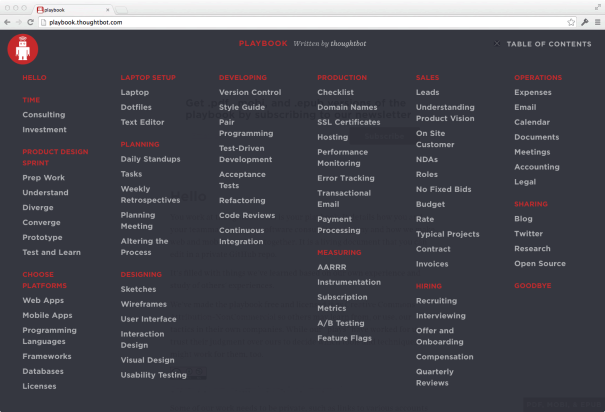Launched: Field Manuals
Field Manuals is a process library for making the web. It documents the principles, standards, and practices that GravDept works by.
Long have I deferred sharing how GravDept operates: workflow, technique, priority, standards, tools, configuration, style, argument, and logic.
Often people blog about their methods, but the inherent datedness in publishing chronologically bothers me. Blogging is archaeologically invaluable, but it’s a frustrating medium for inferring the big picture. Wikis are too open-ended and brain dumps on GitHub too narrow.
compendium — (noun) a concise, yet comprehensive compilation of a body of knowledge.
A compendium is what I wanted — not fragments — a process library for making the web.
I’d never seen anything like that until recently. thoughtbot’s Playbook defines everything from their business model to sketching to code reviews to hiring. It’s a tremendous and impressive resource.

Playbook models the compendium I mean to build, so I can point to an artifact that says, “This is how GravDept currently thinks about XYZ.”
I’m calling it “Field Manuals”
Field Manuals lay out GravDept’s method. They define how I think and maneuver while making the web. The first manuals are style guides for writing quality HTML, CSS, and PHP; and are oriented to working on Magento’s frontend.

I haven’t launched anything this unfinished before. The IA is rushed. Content trails off. Whole pages are empty. But there’s a lot of good stuff too. So I’m putting it out there. Brad Frost calls this designing in the open, and I’m optimistic about launching without perfection.
Etymological significance
Lord of the Rings references are always peppered into my speaking engagements, but also historical military phrases like “news from the front” and “in the trenches”.
I consider my job fieldwork (designing experiments in uncontrolled environments), so naturally I’m writing field manuals (resources for managing uncontrollable environments).
The US Army started producing Field Service Regulations books in 1905. The first US Army Field Manual was published on October 1, 1939 (FM 100–5, Tentative Field Service Regulations, Operations — thirty days after Nazi Germany invaded Poland.
Field Manuals filled the gaps between training and experience in WWII. They were created as a fallback for eroding control, which sounds just like what’s needed working on the web today.
May it be a light to you in dark places, when all other lights go out.
